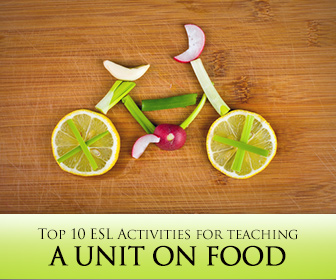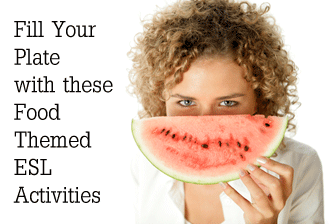Eat, Drink, and Be Merry: Top 10 ESL Activities for Teaching a Unit on Food


Whether you from Asia, Europe, the Americas, Africa or Australia, you eat food. It is an experience common to all people throughout the world. While we all eat, the things that we eat differ not only from one continent to the next but from one household to the next. Regardless, the students in your class will have some experience with food which is why a food unit so often appears in foreign language textbooks. For beginning students, a unit on food is often vocabulary based covering basic terminology and foreign language equivalents. Intermediate students may find themselves in conversation class practicing ordering a meal in English or taking someone else’s order. Advanced students may find food coming up in thematic units, perhaps on ethical or environmental companies. For any level English students, lessons on food are a common occurrence. Whatever level English class you are currently teaching, you can encourage your students to practice their conversation skills and listening skills with the following food-based ESL activities.

The Perfect Meal
If you teach younger students, having them create the perfect meal will allow them to be creative while also teaching them about healthy eating. Start your perfect meal lesson by reviewing what it means to eat in a healthy manner. What types of food should people include in their diets? Encourage your students to share their answers, and then ask them if they know why certain foods are healthier for a person than others. Ask them what makes “bad for you” foods bad. You may be surprised at how much your students know, or you may be shocked at how little they know! So much of that knowledge depends on what they learn at home, but you can do your best to develop informed food consumers. Guide your discussion to talk about the food pyramid. If you need a food pyramid diagram to show your class, you can find several useful images online. The pyramid will list six different food categories: grains, vegetables, fruits, oils, milk and meat/beans. Help your students understand that eating healthy means eating from all of these groups, but the majority of their food should come from grains, vegetables and fruits. Ask if the items that they thought were healthy are listed in the pyramid. If not, can your students think of any other items that might be listed in the food pyramid? Now that your students possess the knowledge of how to eat healthy, have each person design his own perfect meal. Start by having your students divide a paper plate into six wedges with a magic marker (the proportions should more or less match those on the pyramid). Then allow your students to cut pictures from food magazines or draw their own pictures of the foods they would include in each of the six categories to make up their perfect meals. Once they finish, give your students an opportunity to share their perfect meals with a partner or in front of the class. When everyone has had a chance to share, encourage your students to take their plates home and try to eat from all six categories each day to make sure they eat healthy and eat happily.
What Do You Eat With?
If your class includes both westerners and easterners, you may want to have a small discussion on the utensils we use to eat our meals. Divide your class into small groups to discuss which implements they prefer to use at their meals. Most likely, your students will say that they use a fork or chopsticks, but encourage any other options your students may want to share. Encourage each person to share whether their choice is typical of people in their home culture or if their opinion is in the minority. Then give each person a chance to share how he or she feels when using a different utensil. If any of your students are willing, have them offer an opinion as to why the utensil that is most popular in their home culture is preferred over the others. After your class has exhausted the topic, you can also turn your discussion of eating implements into a game. See who can pick up the highest number of shelled peanuts with chopsticks in a sixty-second time period! Another more elaborate activity is to collect several eating and serving tools. You should include pie servers, serving spoons, whisks, sugar spoons, plastic knives, chopsticks and any other items you have available to you. At the beginning of the class period, have each person choose one of the items without telling them what it is for. Later, break the news that the utensils that they chose are the only ones they will be allowed to use to eat a meal or snack you provide. Make sure you check for allergies in your class, and then if it is okay give each person a plate of spaghetti or a bowl of ice cream. Your students will get a laugh trying to use a family sized spoon to scoop noodles into their mouths or eating ice cream with a pie server! Just make sure you have a big sense of humor and plenty of napkins on hand for cleanup!
Plan A Meal
With the holidays right around the corner, ask pairs of students to plan a holiday meal for a group of eight to ten people. Working together, each pair should decide whether they want to have a traditional meal, a nontraditional meal or an international meal. After each pair decides, have them determine what dishes and/or recipes they would need for each type of meal. Make sure you have some general cookbooks available for your students to look through when they are planning. You may also want to play some movie clips from classic holiday films where the characters are sharing their holiday meals. Then using the recipes from the books or others they might know or find in other sources, have each pair determine how much of each ingredient they will need to create their culinary masterpieces. Then using grocery circulars, each pair should determine how much money they would need to cook their feast for their guests. If your students are old enough, have each person bring in a food item to share at a classroom holiday meal. Each person may decide to bring a dish that is traditional in her culture or something unexpected. Again, be aware of any allergies in your class and skip the meal if there are any issues!
It may come in a unit from vocabulary, conversation or home life and culture, but whatever the reason your class is studying food, you can have fun with these conversation based activities. You and your students are sure to want seconds if you do!